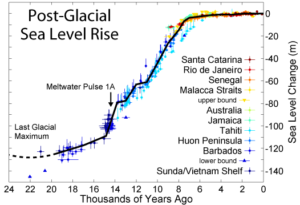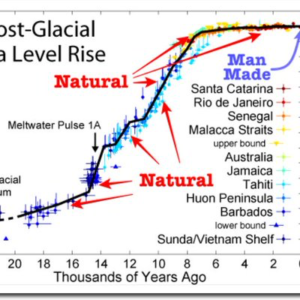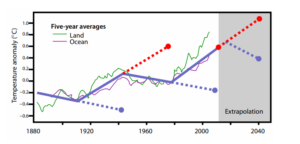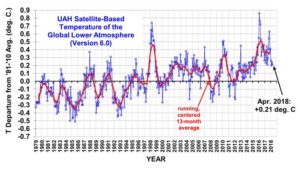by Tony Heller, May 22, 2018 in TheDeplorableClimateScienceBlog
Settled science at NASA means constantly rewriting the past. Here are a few of the NASA Reykjavik, Iceland temperature graphs I have captured over the past six years.
(…)
by Tony Heller, May 22, 2018 in TheDeplorableClimateScienceBlog
Settled science at NASA means constantly rewriting the past. Here are a few of the NASA Reykjavik, Iceland temperature graphs I have captured over the past six years.
(…)
by Andy May, May 19, 2018 in WUWT
Al Gore wrote in the Huffington Post (August 28, 2014) that the need for “bold action” to curtail “old dirty sources of energy … is obvious and urgent.” The proper scientific response to an assertion like that is why? How can I test this idea? Science is not a belief, it is a method of testing ideas. We use an idea to make predictions and then we gather data to see if the predictions are correct. If the predictions are accurate, the idea survives. If any of the predictions fail, the idea is disproven, and it must be modified or simply rejected.
by James Spry, April 19, 2018 in Climatism
A new study, published in Nature by serial reef alarmist Prof Terry Hughes, Director of the ARC Centre of Excellence for Coral Reef Studies at James Cook University, examines the link between the level of heat exposure from the 2015/16 super El Niño, “resulting in coral bleaching and ultimately coral death.“
(…)
See aslo here
by Wikimedia Commons, 2018
Over the last 20,000 years, sea level has rise about 400 feet. @algore say the last 2 inches are your fault (in Steve Goodard, May 20, 2018)


by Tony Heller, May 19, 2018 in ClimateChangeDispatch
Sixty years ago, the New York Times predicted ships would be sailing over the North Pole “within the lifetime of our children.”
….
TimesMachine: October 19, 1958 – NYTimes.com
And 60 years later, both the Northwest Passage and Northern Sea Route are blocked by 12-foot thick ice.
by Ron Clutz, May 16, 2018 in ScienceMatters
Thanks to GWPF for publishing posthumously Bill Gray’s understanding of global warming/climate change. The paper was compiled at his request, completed and now available as Flaws in applying greenhouse warming to Climate Variability This post provides some excerpts in italics with my bolds and some headers. Readers will learn much from the entire document (title above is link to pdf).
The Fundamental Correction
The critical argument that is made by many in the global climate modeling (GCM) community is that an increase in CO2 warming leads to an increase in atmospheric water vapor, resulting in more warming from the absorption of outgoing infrared radiation (IR) by the water vapor (…)

Figure 14: Global surface temperature change since 1880. The dotted blue and dotted red lines illustrate how much error one would have made by extrapolating a multi-decadal cooling or warming trend beyond a typical 25-35 year period. Note the recent 1975-2000 warming trend has not continued, and the global temperature remained relatively constant until 2014.
by Q. Lejeune et al., April 23, 2018 in Nature
The effects of past land-cover changes on climate are disputed. Previous modelling studies have generally concluded that the biogeophysical effects of historical deforestation led to an annual mean cooling in the northern mid-latitudes, in line with the albedo-induced negative radiative forcing from land-cover changes since pre-industrial time reported in the most recent Intergovernmental Panel on Climate Change report. However, further observational and modelling studies have highlighted strong seasonal and diurnal contrasts in the temperature response to deforestation
(…)
by M. Khandekar, April 27, 2018 in TroyMedia
It’s been a long winter.
I should know. I’m a former climate research scientist at Environment Canada. And I was an expert reviewer for the United Nations’ International Panel on Climate Change (IPCC) and its 2007 Climate Change Report.
The wintry weather held its grip over most of Canada well into April, from Vancouver to St. John’s, as snow, freezing rain, ice pellets and ferocious winds hammered everyone. A few noteworthy wintry tales:
Calgary is set for record snowfall.
Edmonton set a record for continuous days of below-freezing temperatures this winter.
Most of the Canadian Prairies were still in winter-like weather mode in mid-April.
Toronto has recorded one of the highest numbers of Heating Degree Days at 3,485 and counting.
Atlantic Canada braced for more wintry weather with snow accumulation of 10 to 25 cm in mid-month.
This year’s winter could be the longest, snowiest and coldest in 40 years.
(…)
by Anthony Watts, may 17, 2018 in WUWT
By investigating fossils, Prof. Kießling and Dr. Carl Reddin, who is also at GeoZentrum Nordbayern, have shown that coral, molluscs, and sponges have been following their preferred cold and warm zones for half a billion years. Isotherms (geographic lines denoting the same temperature, for example 20°C) shift towards the poles or the equator as soon as the global temperature rises or decreases. Isotherms have been shifting towards the poles for several years due to global warming.
The tendency towards climate-related migration is most apparent in tropical species. This may be due to the fact that several of these species live near the thermal maximum for complex organisms of 35-45°C . Current global warming trends are driving marine animals towards the poles, provided there is a suitable habitat they can migrate to.
by Eric Worrall, May 16, 2018 in WUWT
The researchers claim adding historical data derived fudge factors to correct the discrepancy between climate models and historical observations, producing a Frankenmodel mix of fudge factors and defective physics, will make climate predictions more reliable (…)
by Fred Singer, May 15, 2018 in TheWallStreetJournal
It is generally thought that sea-level rise accelerates mainly by thermal expansion of sea water, the so-called steric component. But by studying a very short time interval, it is possible to sidestep most of the complications, like “isostatic adjustment” of the shoreline (as continents rise after the overlying ice has melted) and “subsidence” of the shoreline (as ground water and minerals are extracted).
I chose to assess the sea-level trend from 1915-45, when a genuine, independently confirmed warming of approximately 0.5 degree Celsius occurred. I note particularly that sea-level rise is not affected by the warming; it continues at the same rate, 1.8 millimeters a year, according to a 1990 review by Andrew S. Trupin and John Wahr. I therefore conclude—contrary to the general wisdom—that the temperature of sea water has no direct effect on sea-level rise. That means neither does the atmospheric content of carbon dioxide.
by A. Watts, May 15, 2018 in WUWT
NASA says the greening of the planet is due to increased CO2, these guys are arguing against that, saying increased forest growth “correlates strongly to the UN Development Programme’s Human Development Index”. Riiiighht. They say that “Europe’s early turnaround and expansion of forest resources obviously can’t be attributed to the rapid rise of atmospheric carbon dioxide that began decades later”. By the same token, the U.N. didn’t exist until decades later, and they sure as hell haven’t had any impact on the greening of the Eastern United States as shown in their map below (…)
by Mathew Carr, May 11, 2018 in WashingtonPost
Two weeks of climate talks organized by the United Nations finished with developing countries demanding more clarity from their richer counterparts on when a promised package of $100 billion in aid will materialize.
Envoys from almost 200 nations are leaving Bonn, Germany, on Thursday without producing a draft negotiating text for ministers to discuss at the end of the year. Instead, they planned another round of negotiations in Bangkok before their annual conference in Poland in December.
The holdup threatens to unravel three years of work to complete the Paris Agreement, a landmark deal reached in 2015 that set out an ambition to limit fossil-fuel pollution in all nations for the first time (…)
by K. Richard, May 10, 2018 in NoTricksZone
During 2017, there were 150 graphs from 122 scientific papers published in peer-reviewed journals indicating modern temperatures are not unprecedented, unusual, or hockey-stick-shaped — nor do they fall outside the range of natural variability. We are a little over 4 months into the new publication year and already 81 graphs from 62 scientific papers undermine claims that modern era warming is climatically unusual.
by Tony Heller, May 12, 2012 in TheDeplorableClimSciBlog
Ninety-five degree temperatures were common in the Midwest during May prior to 1940, but almost never happen any more. May afternoon temperatures have been declining in the Midwest since the 19th century. The hottest May (by far) was 1934, when 100 degree temperatures were widespread across the Midwest, including 101 degrees at Algona, Iowa on May 7th, 1934.
See also The Good News And The Bad News
by R. Lindsey, NOAA, May 11, 2018 in WUWT
Why do U.S. climate forecasters pay so much attention to a pattern that operates in the remote tropical Pacific? Because the Pacific is the world’s biggest ocean, and disruptions to its climate have a long reach. The seesawing changes in tropical rainfall, winds, and ocean temperature that accompany La Niña and its warm-phase partner, El Niño, trigger a cascade of potentially predictable impacts on seasonal climate in the United States and beyond.
by Matt McGraph, May 10, 2018 in BBC-Sci&Env
UN negotiations in Bonn are set to end in stalemate today as delegates have become bogged down in technical arguments about the Paris climate pact.
Poorer nations say they are fed up with foot dragging by richer countries on finance and carbon cutting commitments.
Some countries, led by China are now seeking to renegotiate key aspects of the Paris agreement.
See also : China Wants To Renegotiate The Paris Climate Accord
See also : Bonn bombs, climate pact in disarray
by Ron Clutz, May 8, 2018 in ScienceMatters
Years ago, Dr. Roger Pielke Sr. explained why sea surface temperatures (SST) were the best indicator of heat content gained or lost from earth’s climate system. Enthalpy is the thermodynamic term for total heat content in a system, and humidity differences in air parcels affect enthalpy. Measuring water temperature directly avoids distorted impressions from air measurements. In addition, ocean covers 71% of the planet surface and thus dominates surface temperature estimates.
More recently, Dr. Ole Humlum reported from his research that air temperatures lag 2-3 months behind changes in SST. He also observed that changes in CO2 atmospheric concentrations lag behind SST by 11-12 months. This latter point is addressed in a previous post Who to Blame for Rising CO2?
by Mikko Paunio, May 5, 2015 in GWPF
The report (.pdf, 11 pages), by eminent epidemiologist Mikko Paunio, says that international bodies and NGOs are trying to prevent poor countries from expanding their use of conventional fuels, have abandoned the so-called “energy ladder” — the gradual shift to cleaner types of fuel that underpinned the clean up of air quality in industrialised nations.
As Dr Paunio explains, this will have devastating consequences:
“Indoor air pollution from domestic fires kills millions every year. But instead of helping poor people to climb the energy ladder and clean the air in their communities, the poorest people are being given gimmicks like cookstoves, which make little difference to air quality, and solar panels, which are little more than a joke.”
by Tony Heller, May 2, 2018 in TheDeplorableClimateScience
Measured US temperatures show cooling over the last 90 years. This doesn’t suit the needs of the climate mafia, so NOAA massively alters the data to turn cooling into warming. NOAA cools the past by more than one degree, and warms the present by nearly one degree. Then other climate scientists use this fake data to confirm fake theories about CO2 emissions warming the planet.
by A. Watts, May 2, 2008 in WUWT
A new study by climatologists Nicholas Lewis and Judith Curry concludes that Earth’s “equilibrium climate sensitivity” (ECS) to more atmospheric carbon dioxide is as much as 50% lower than climate alarmists have been claiming. That their paper was published in the Journal of Climate suggests that the asserted “97% consensus” of climate experts may be eroding.
Or as Cornwall Alliance founder Cal Beisner puts it (paraphrasing Winston Churchill) it may not be the beginning of the end of climate alarmism. But it could be the end of the beginning of alarmism as the dominant, ever-victorious tenet of our times.
Indeed, say other noted climatologists, there are good reasons to think ECS and alarmist errors are even greater than 50 percent. For one thing, there is no persuasive reason to assume our planet’s climate system (…)
by P. Homewood, May 2, 2018 in NotaLotofPeopleKnowThat
For several decades now, Antarctica has not been cooperating with the “global” warming narrative, as the continent as a whole has not been warming.
Several scientific papers have been published recently that document the lack of an anthropogenic warming signal for the Antarctic continent or the surrounding ocean, as well as the dominance of natural variability (…)
by Roy S. Spencer, Ph.D. May 1, 2018 in WUWT
The Version 6.0 global average lower tropospheric temperature (LT) anomaly for April, 2018 was +0.21 deg. C, down a little from the March value of +0.24 deg. C

Global area-averaged lower tropospheric temperature anomalies (departures from 30-year calendar monthly means, 1981-2010). The 13-month centered average is meant to give an indication of the lower frequency variations in the data; the choice of 13 months is somewhat arbitrary… an odd number of months allows centered plotting on months with no time lag between the two plotted time series. The inclusion of two of the same calendar months on the ends of the 13 month averaging period causes no issues with interpretation because the seasonal temperature cycle has been removed, and so has the distinction between calendar months.
by M. Bastach, April 30, 2018 in ClimateChangeDispatch
Roughly 20 years ago, climate scientist Michael Mann published his famous “hockey stick” graph that he says “galvanized climate action” by showing unprecedented global warming.
Mann used the 20-year anniversary of the graph to opine on the “industry-funded” attacks “to discredit the iconic symbol of the human impact on our climate,” which Mann claimed had withstood criticism.
“Yet, in the 20 years since the original hockey stick publication, independent studies, again and again, have overwhelmingly reaffirmed our findings, including the key conclusion: recent warming is unprecedented over at least the past millennium,” Mann wrote in Scientific American on April 20.
However, the two Canadian researchers who found serious flaws in the “hockey stick” study’s data and methodology disputed Mann’s characterization of the graph’s legacy.
(…)
by James Holloway, April 19, 2018 in NewAtlas,
Scientists at the Chinese Academy of Sciences have put together the first global carbon dioxide maps based on data from the Chinese satellite TanSat. The satellite also measures what lead researcher Yang Dongxu calls “carbon dioxide flux,” changes in its behavior on Earth and in the Earth’s atmosphere.